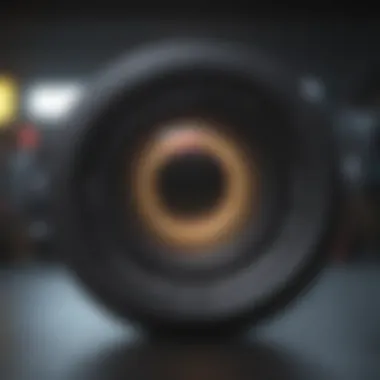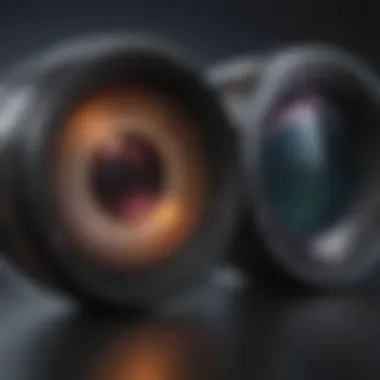Multifocal Lens Replacement Reviews Explained


Intro
The field of ophthalmology constantly evolves. One notable advancement is multifocal lens replacement, a procedure that can substantially improve a patient's vision. With a vast array of reviews and patient experiences available, understanding this procedure is essential for anyone considering it. This article seeks to clarify multifocal lens replacement by presenting various insights and expert evaluations.
The process of multifocal lens replacement involves removing the eye's natural lens and substituting it with an artificial, multifocal lens. Such lenses allow patients to focus on objects at different distances without needing glasses. As with any surgical procedure, understanding the risks, drawbacks, and benefits is crucial. The following sections will provide an outline of current trends, research findings, and patient experiences in this area.
Preamble to Multifocal Lens Replacement
The journey to perfect vision is a significant pursuit in today's rapidly progressing medical field. This article focuses on multifocal lens replacement, a key option in vision correction. With an increasing number of individuals experiencing presbyopia or other age-related vision issues, understanding multifocal lenses is crucial.
What are Multifocal Lenses?
Multifocal lenses are designed to provide multiple focal points. These lenses allow users to see clearly at various distances, reducing the need for multiple pairs of glasses. Typically, they feature distinct zones tailored for distance, intermediate, and near vision. The primary goal is to restore functional vision for those who have lost it due to age or other conditions.
Historical Context
The evolution of multifocal lens technology has a rich history. Initially, bifocal lenses were the only option available, providing distance and near vision but not intermediate. The introduction of trifocal lenses broadened this scope. However, it was the advent of progressive lenses that revolutionized vision correction, creating seamless transitions between different focal areas. This progression marks a significant milestone in ophthalmology, leading to the development of more advanced multifocal options.
Current Trends in Vision Correction
Today, the landscape of vision correction continues to evolve. Various trends are redefining how multifocal lenses are perceived and utilized. With advancements in technology, personalized solutions are becoming commonplace. Laser-assisted procedures and customized lens designs are enhancing accuracy and patient satisfaction. Moreover, increased awareness of the benefits of multifocal lenses is encouraging more patients to consider them. This shift underscores the growing importance of multifocal lens solutions in modern eye care.
Types of Multifocal Lenses
Understanding the different types of multifocal lenses is crucial for anyone considering vision correction options. This section outlines the major categories of multifocal lenses and their unique characteristics. It also highlights how the distinctions between these types influence patient choices and outcomes.
Differences Between Fixed and Adjustable Lenses
Fixed multifocal lenses, as their name suggests, have set focal points that do not change. They often provide clear vision at multiple distances—usually near, intermediate, and far. However, they do not allow for any adjustment after implantation. This can be advantageous for patients who prefer consistency in their vision.
In contrast, adjustable lenses offer the flexibility to modify the vision correction after the surgery. By using external devices or mechanisms, the focal points can shift based on the user's needs. Such lenses may provide a more tailored visual experience, accommodating changing vision requirements with age or lifestyle. This adaptability can prove beneficial for patients engaged in varied tasks.
Technology Behind Multifocal Lenses
Advancements in technology play a significant role in the effectiveness of multifocal lenses. Modern multifocal lenses usually employ sophisticated designs that incorporate advanced optics. This is to overcome common problems such as glare and halos, which may occur with simpler models.
Optical designs often combine different lens powers within a single lens. Notably, newer designs can achieve smoother transitions between focal points. Techniques such as diffraction and refractive designs are used in the creation of these lenses, enhancing clarity for patients across varied distances. Innovations like these make it possible for patients to experience less distortion and more natural vision.
Innovative Designs in Multifocal Lenses
Recent years have seen significant innovations in the designs of multifocal lenses, aiming to improve comfort and visual experience. For instance, recent models may feature a gradual change in lens power, known as a progressive lens design. This contrasts with older designs which often had abrupt transitions.
Some innovative lenses include materials that also enhance light transmission and reduce the distortion at the lens edges. There are now also lenses specifically designed for those who frequently use digital screens. These designs help to alleviate digital eye strain, offering shield from blue light while maintaining clear vision.
In summary, the different types of multifocal lenses — whether fixed or adjustable — and the technology behind their designs hold great importance in vision correction. These factors directly influence visual outcomes and overall patient satisfaction.
Advantages of Multifocal Lens Replacement
The topic of multifocal lens replacement holds significant relevance in today’s evolving landscape of vision correction. These innovative lenses offer unique benefits that can dramatically enhance visual performance for many individuals. Understanding the advantages can help patients make informed decisions regarding their eye care.
Improved Visual Acuity
One of the primary advantages of multifocal lenses is the enhancement of visual acuity at various distances. With traditional lenses, individuals may find themselves frequently adjusting their glasses or switching between different pairs for near and far vision. Multifocal lenses, on the other hand, provide a smooth transition between different focal points. This means that patients can enjoy a clearer view whether they are reading a book or looking at a distant object.


Research suggests that many patients experience improved overall visual satisfaction. A study published on britannica.com shows that individuals using multifocal lenses report higher levels of visual clarity and a reduced need for additional corrective eyewear. This improvement is particularly beneficial for those who lead active lifestyles or work in detail-oriented professions.
Reduced Dependence on Eyeglasses
Another substantial advantage is the reduced dependence on eyeglasses. Many people with presbyopia or other age-related vision issues often rely heavily on their glasses for daily tasks. Multifocal lens replacement allows individuals to regain independence from their spectacles. This can be especially liberating, as patients may feel more free to engage in activities without the hassle of managing multiple pairs of glasses.
Furthermore, less dependence on eyeglasses translates into savings over time. Patients no longer need to purchase multiple lenses for different purposes, which can add up significantly. Multifocal lenses can also enhance comfort, as they are less likely to fog up or get lost, which are common frustrations with traditional glasses.
Enhanced Quality of Life
Ultimately, multifocal lens replacement contributes to an enhanced quality of life. The flexibility these lenses afford translates into greater engagement in daily activities, such as reading, driving, and participating in social events without the worry of impaired vision.
Many patients report feeling more confident and secure in their visual capabilities following the procedure. This increase in confidence can positively influence mental health and social interactions. As shown in numerous testimonials, such improvements go beyond just vision; they can enrich personal experiences and relationships.
To conclude, the advantages of multifocal lens replacement are multifaceted. From improved visual acuity to reduced reliance on glasses, and an enhanced quality of life, these lenses present a compelling option for those navigating age-related visual challenges. By recognizing these benefits, patients are better equipped to consider multifocal lens replacement as a viable solution for their vision needs.
Challenges and Considerations
Understanding the challenges and considerations associated with multifocal lens replacement is essential for anyone evaluating this vision correction option. This section emphasizes the significance of recognizing potential complications, eligibility criteria, and financial implications. With detailed insights into these areas, patients can make informed decisions and prepare adequately for their surgical journey.
Common Complications and Side Effects
Despite the advantages of multifocal lens replacement, complications can arise. Common issues include glare and halos around lights, particularly at night. Many patients report experiencing fluctuations in their vision during the healing process. These phenomena can be unsettling.
Other side effects might involve dry eyes or an increased need for reading glasses for certain tasks. It is also possible to encounter issues where one lens might perform differently than the other, leading to an imbalance in vision. Understanding these complications is crucial as they can influence overall satisfaction with the procedure.
"Most patients experience some discomfort or visual disturbances post-operatively, but many adapt successfully over time."
It is advisable for individuals considering this replacement to discuss these potential side effects with their eye care professional. They can provide more information about the likelihood of experiencing these issues.
Patient Eligibility Criteria
Not everyone is suitable for multifocal lens replacement. Age, existing eye conditions, and overall health play significant roles in determining eligibility. Generally, candidates should be at least 40 years old as presbyopia often develops around this age.
Eye diseases such as cataracts, glaucoma, or severe dry eye syndrome can also disqualify patients from this procedure. On the contrary, individuals free from these conditions are usually considered ideal candidates. It is essential to undergo a comprehensive eye examination to evaluate suitability.
Regular follow-ups with an ophthalmologist can also ensure that a patient remains a viable candidate throughout the surgical process.
Cost and Insurance Issues
The costs associated with multifocal lens replacement can be considerable and vary significantly. On average, the price for the procedure ranges from several thousand to tens of thousands per eye, depending on various factors, including technology used and the surgeon’s expertise.
Insurance often complicates the financial aspect. Many insurance companies classify multifocal lenses as elective procedures. As a result, coverage may be limited. Patients should carefully review their insurance policies before committing to the surgery.
To navigate these costs, many clinics offer payment plans or financing options. Patients should inquire about the financial implications during their initial consultations. Understanding these considerations allows prospective patients to prepare better for the financial commitments involved.
Surgical Procedure and Techniques
The surgical process involved in multifocal lens replacement is a critical aspect to understand for anyone considering this vision correction solution. This section will provide a detailed overview of the essential components of the surgical techniques that aim to restore and enhance vision quality. The importance of these procedures cannot be understated; they form the foundation upon which successful outcomes in multifocal lens replacement are built. Ensuring that both the surgical methods and post-operative care are thoroughly understood can lead to a more positive experience for patients.
Pre-operative Assessments
Pre-operative assessments play a vital role in determining the suitability of a patient for multifocal lens replacement. These assessments typically begin with a comprehensive eye examination. Eye doctors will evaluate the overall health of the eyes, including the presence of any underlying conditions that could impact surgical results.
The evaluations include a detailed measurement of the cornea and refractive errors, which helps in creating a tailored surgical plan.


Key components often involve:
- Visual acuity tests: These measure how well a patient can see at various distances.
- Retinal examination: It checks the health of the retina and screens for various eye diseases.
- Corneal topography: This mapping technique helps define the curvature of the cornea.
- Pachymetry: It measures the thickness of the cornea, which is crucial for surgery decisions.
Understanding these assessments is paramount for gauging the likelihood of achieving optimal visual outcomes. Only after these evaluations can patients move forward with informed consent regarding their surgical options.
Surgical Techniques in Multifocal Lens Replacement
Surgical techniques vary, but the most common method used for multifocal lens replacement is phacoemulsification. This procedure involves breaking up the natural lens using ultrasonic vibrations before removing it. After the lens is removed, an artificial multifocal lens is implanted in its place. This technique is minimally invasive, reducing recovery time and the risk of complications.
Some specifics about the technique include:
- Anesthesia options: Local anesthesia is typically used, allowing patients to remain awake but free from pain during the procedure.
- Surgical precision: Modern equipment ensures high accuracy in lens positioning, critical for achieving the desired visual outcomes.
Proper surgical technique is essential for minimizing side effects and enhancing the overall efficacy of the procedure. Surgeons must also adapt to each patient's unique ocular anatomy to ensure optimal placement of the multifocal lens.
Post-operative Care Protocols
Post-operative care is just as important as the surgery itself. Following the procedure, patients usually experience some degree of discomfort. This is normal, but following the prescribed care plan helps in reducing complications and facilitating recovery.
Key elements of post-operative care include:
- Follow-up appointments: Regular check-ups with the eye care specialist to monitor healing and vision.
- Medications: Anti-inflammatory drops and possibly antibiotics to prevent infection are often prescribed.
- Activity restrictions: Patients may be advised to avoid certain activities, such as heavy lifting or swimming, for a specified period to ensure proper healing.
Patient compliance with these protocols is critical. It can greatly influence the success and satisfaction of the surgical outcome.
"Understanding the entire process - from assessments to post-operative care - empowers patients to be more active participants in their vision correction journey."
Patient Experiences and Testimonials
The patient experiences and testimonials section is crucial in understanding the real-world implications of multifocal lens replacement. Through personal narratives and shared experiences, potential candidates can gain insight into expected outcomes, challenges faced during recovery, and overall satisfaction. These accounts help demystify the procedure, offering a realistic perspective to individuals considering this surgical option. Highlighting the diverse journeys of patients illustrates the range of effects this surgery can have, both positive and negative.
Personal Stories from Patients
Many patients have shared their multifocal lens replacement journeys, revealing an array of experiences influenced by individual circumstances. For instance, John, a retired teacher, expressed a sense of liberation after undergoing the procedure. "I used to rely heavily on reading glasses, but now I can enjoy my books without any hindrance," he noted. Meanwhile, another patient, Maria, faced some adjustment challenges but emphasized the importance of persistence. "The first few weeks were tough, but with time, my vision adjusted, and I'm happier now than ever."
These stories underscore not only the personal outcomes but also the differing expectations individuals might have. By learning from others, potential patients can better prepare themselves mentally and physically.
Impact on Daily Activities
The influence of multifocal lenses on everyday life is noteworthy. Many individuals report a significant enhancement in their ability to perform daily tasks with ease. For example, activities like reading, driving, and using devices become simpler and more enjoyable. Kelly remarked, "I can now see my grandkids’ faces clearly while playing at the park. It feels fantastic to be fully involved again."
Conversely, some patients, like David, pointed out initial difficulties with depth perception while adapting to their new lenses. Such experiences highlight the need for thorough follow-ups with eyecare professionals to ensure any complications are addressed early.
Long-term Satisfaction Rates
Long-term satisfaction rates are often a decisive factor in assessing the success of multifocal lens replacements. Several studies indicate that most patients report high levels of satisfaction post-surgery. A notable study indicated that about 80% of individuals are satisfied with their vision after one year.
One contributing aspect is the reduction in the need for glasses, which many patients highly value. As Karen put it, "The freedom from glasses has changed my life. I can go hiking and choose glasses-free beaches!"
However, it’s important to understand that satisfaction can vary based on pre-existing conditions, patient expectations, and post-operative care. As such, assessing these satisfaction metrics can provide valuable guidance for prospective patients, aligning their expectations with realistic outcomes.
Comparative Studies and Research Data
Comparative studies and research data play a crucial role in the evaluation of multifocal lens replacement. They provide a structured framework for assessing the effectiveness and safety of these lenses against alternative options, particularly monofocal lenses. The analysis of such data helps in determining patient outcomes, identifying potential complications, and understanding which demographics benefit the most from these procedures.


The incorporation of comparative studies can guide prospective patients in making informed decisions, aligning their choices with evidence-based conclusions. Furthermore, studies provide insights into advancements in lens technology and surgical techniques. They often highlight shifts in trends and contribute to ongoing discussions within the medical community about best practices.
Clinical Trials Overview
Clinical trials focus on rigorous testing of multifocal lenses in controlled environments. These trials evaluate various factors, including patient selection and the specific design of lenses used. In many trials, participants are closely monitored for a predetermined period to gauge their recovery and visual outcomes. Notable trials often include a diverse set of participants to ensure the findings are generalizable to broader populations.
Results from these trials contribute significantly to our understanding of the safety profile of multifocal lenses. For example, findings can reveal if certain lenses lead to higher incidences of glare or halos compared to others, enabling practitioners to tailor their recommendations.
"Understanding clinical trial data is key for both patients and surgeons alike; it shapes the conversation around multifocal lens safety and efficacy."
Comparisons with Monofocal Lenses
When examining multifocal lenses, it is essential to contrast them with monofocal lenses. Monofocal lenses offer clarity at a single focal point, whereas multifocal lenses are designed to provide multiple focal points, allowing patients to see clearly at different distances.
Studies typically reveal that multifocal lenses can reduce the need for glasses significantly compared to monofocal alternatives, particularly in individuals with presbyopia. However, some research also notes that while multifocal lenses improve convenience, they may not always achieve the same level of visual acuity in all scenarios, especially in low-light conditions.
Understanding the specific advantages and limitations of each lens type is vital for patients as they weigh their options for lens replacement.
Analyses of Visual Outcomes
The examination of visual outcomes after multifocal lens replacement relies on specific metrics, such as distance vision, near vision, and contrast sensitivity. Several studies have indicated that patients generally experience substantial improvements in their overall vision and satisfaction.
Importantly, post-operative assessments often highlight variations among different populations, influenced by factors such as age or pre-existing eye conditions.
Overall, the analyses reinforce the concept that while multifocal lenses can offer considerable benefits, the decision should be carefully considered, factoring in individual circumstances and expected visual demands. The clarity provided by various research conclusions assists in informing both clinical practice and patient expectations.
Future Directions in Multifocal Lens Replacement
The landscape of multifocal lens replacement is continually evolving, influenced by advancements in technology and the changing needs of patients. Understanding the future directions in this field is essential for patients, eye care professionals, and researchers alike. It highlights not only the potential innovations that may enhance patient outcomes but also the broader implications these advancements hold for vision correction as a whole.
Innovations on the Horizon
As the demand for effective vision solutions grows, innovations in multifocal lens technology are likely to address several ongoing challenges. For instance, future lens designs may integrate advanced materials that offer greater durability and enhanced visual performance. Researchers are also exploring adaptive optics that could customize visual experiences to individual patient needs. By improving lens flexibility and refining light management, these innovations could potentially eliminate common issues such as glare and halos, which are often reported by multifocal lens users.
Emerging Technologies in Eye Care
Emerging technologies such as digital imaging and artificial intelligence are set to revolutionize the eye care field. These tools can provide eye care professionals with more precise measurements and data analysis, leading to better patient outcomes. For instance, AI can help predict how specific multifocal lenses will function for individual patients, taking into account personal lifestyle and visual requirements. Moreover, the integration of telemedicine into eye care could facilitate easier access to consultations and follow-up assessments, ensuring patients receive timely and tailored care in their multifocal lens journey.
Predictions for Market Growth
The multifocal lens replacement market is anticipated to grow significantly in the coming years, driven by an aging population and increased awareness of vision correction options. This growth opens new opportunities not just for pharmaceutical companies but also for researchers and healthcare providers involved in developing advanced options for patients. According to industry reports, the market for multifocal lenses may see notable increases in investment as technologies become more widely adopted. Identifying how this growth will shape the future of eye care allows stakeholders to remain ahead of trends and prepare for the evolving needs of patients seeking improved vision solutions.
"The future of multifocal lens replacement is about personalizing visual experiences and leveraging technology for better patient care.”
In summary, the future of multifocal lens replacement appears promising with the upcoming innovations, technological advancements, and market growth projected in the upcoming years. Stakeholders must remain informed about these trends to enhance their understanding and engagement within this dynamic field.
The End
The conclusion of this article plays a pivotal role in synthesizing the knowledge gained throughout the discussion of multifocal lens replacement. It serves as a critical reflection point for readers, highlighting the intricate balance between the benefits and challenges associated with this vision correction procedure. Understanding these factors is essential for anyone considering multifocal lens replacement. This thoughtful analysis assists in ensuring that patients make informed decisions aligned with their specific visual needs and lifestyle preferences.
Recap of Key Findings
In reviewing the multifocal lens replacement process, several key findings emerge:
- Enhanced Vision: Multifocal lenses provide improved visual acuity at various distances, allowing for a more natural visual experience without the need for multiple pairs of glasses.
- Patient Experiences: Case studies indicate that many patients experience significant improvements in daily activities, fostering a greater sense of independence.
- Surgical Safety: The advancements in surgical techniques have improved the safety and effectiveness of the procedure, resulting in fewer complications and a more streamlined recovery process.
- Personalization is Key: Each patient's needs vary, making personalized assessments critical in determining eligibility and optimal lens choices.
By systematically addressing these elements, the article emphasizes that multifocal lens replacement is not a one-size-fits-all solution but rather a tailored approach to individual vision needs.
Final Thoughts on Multifocal Lens Replacement
"Understanding multifocal lens replacement not only enhances clarity of vision but also enriches quality of life, necessitating informed choices through thorough research and discussions with professionals."



